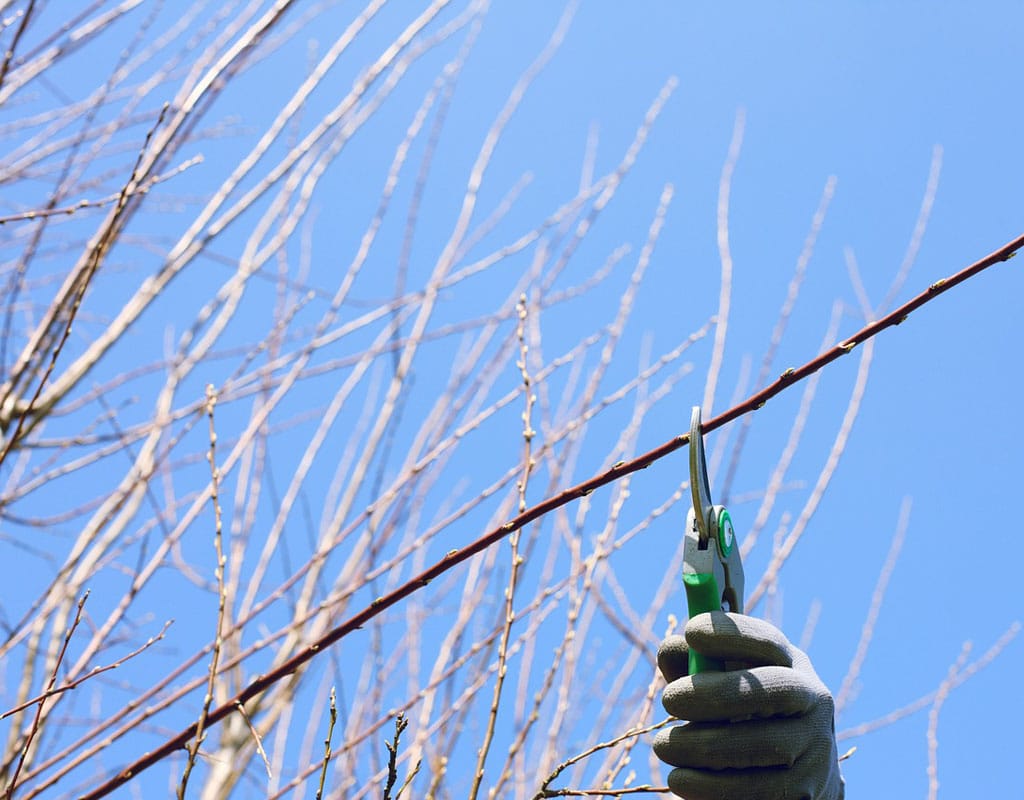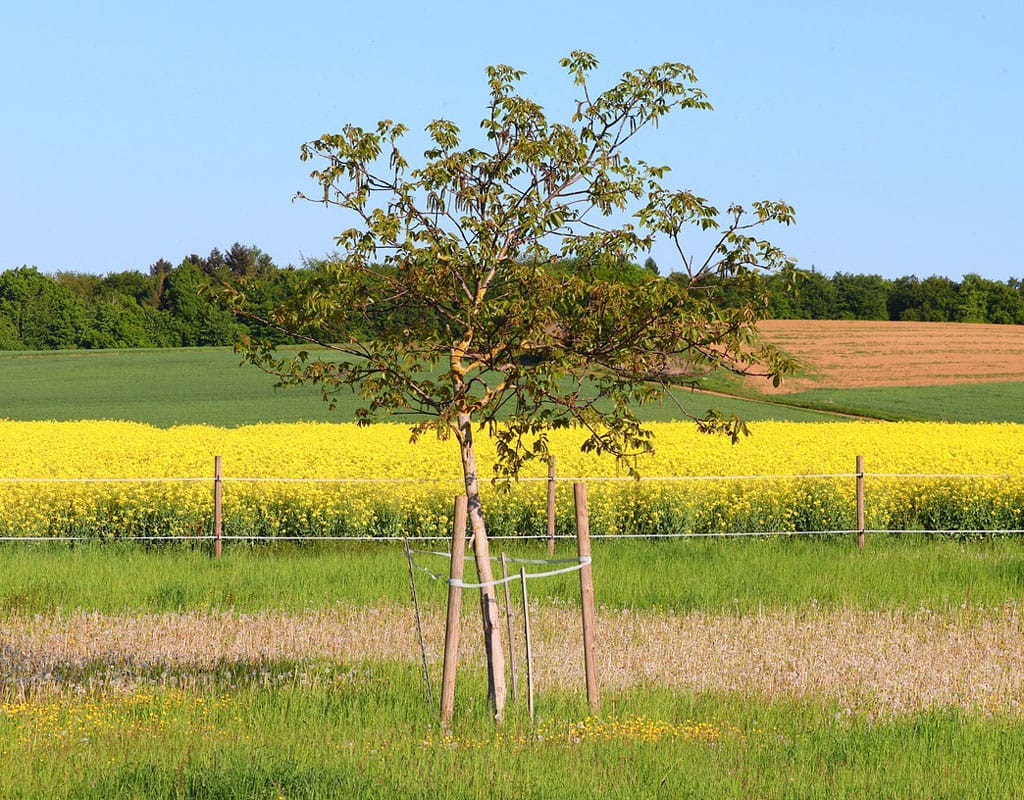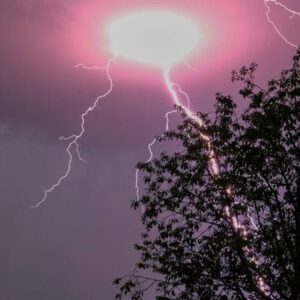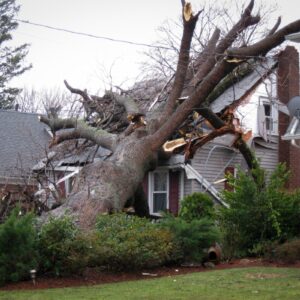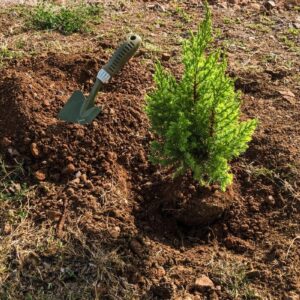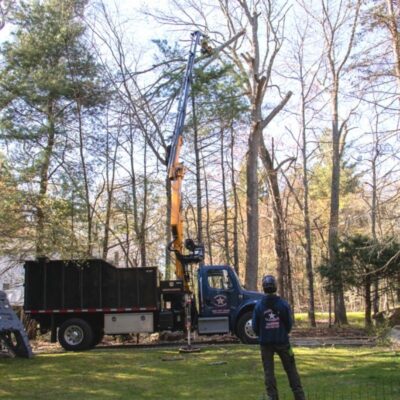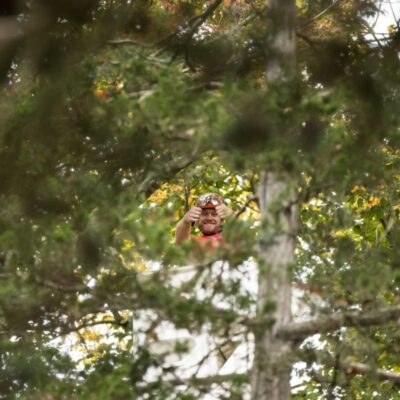We agree that homeowners can do some tree work themselves, instead of hiring a tree service company. With that being said, there are some limitations to the extent of DIY tree care we recommend!
The key is safety – for you and your family, your neighbors, and your trees.
Read on to learn the types of tree work we encourage you to try yourself (with the proper equipment, knowledge, and precautions, of course!) and when you should call us instead.
What You Should NOT Do Yourself
First things first. We do NOT recommend that you try to cut down a tree yourself.
Sure, anyone can buy a chainsaw and start hacking away at a tree. But without extensive experience and knowledge about how a tree reacts when under stress (such as when it’s being cut down), you leave yourself open to serious injury and damage to your or your neighbor’s property. Homeowners are killed every week trying to remove a tree without the help of a tree care professional. Just don’t do it!
Take Safety Seriously!
The risk of injury from tree work is real, and you should be prepared with the right equipment. Personal protective equipment (PPE) is a must. You’ll want safety glasses or goggles to protect your eyes from falling debris and branches, a hardhat if you’re pruning above your eye level, and gloves that will allow you to grip your tools securely. You should also wear sturdy shoes meant for outdoor work, and heavy clothing that will resist tearing from branches and that you don’t mind getting dirty with debris and sap.
Get Some Knowledge Before You Start
There are lots of ways to damage your trees if you don’t do the job properly but it’s also absolutely possible to learn how to do basic tree care tasks correctly. Your trees will (hopefully) be around for a long time so a bit of education about how to properly care for them is a wise investment. Besides, nobody wants to be known as the person who killed their tree or turned it into a coat rack!
Good resources for homeowners include treesaregood.org and the University of Massachusetts fact sheets on trees.
Learn about The Real Cost of Poor Tree Care
Tree Work to do Yourself
Prune Your Trees
Pruning is something many homeowners tackle on their own, often without proper training or an understanding of how trees respond to different types of pruning cuts. Be sure you know what you’re doing before you start. Bad tree pruning isn’t like a bad haircut that will grow out – the wrong pruning cuts can leave your trees vulnerable to disease and pests, and can ruin the branching structure and form of your tree’s crown. These translate into more money later on, as well as unnecessary stress on your trees as they try to seal off wounds.
That said, pruning is one of the more satisfying tree care tasks you can do yourself and, when done correctly, can have a significant impact on the appearance and health of your trees.
Note: Depending on the time of year, you should also check your trees for nesting birds. If you have birds living in your trees and those trees are not posing a danger to anyone or anything, wait to prune until babies have fledged or migratory birds have moved on. We rely on birds of all sizes to keep insect populations low, so give them a little space!
See the Pruning Mistakes to Avoid
Learn When to Prune Trees & Shrubs
Stay on the Ground When Pruning
We always counsel homeowners to prune from ground level, using hand tools and telescoping pruners to prune what you can safely reach while keeping your feet on the ground. Staying on the ground means you are stable, safe from falls, and that you can easily get out of the way of falling branches, leaves, insects, and dripping sap. You also avoid the risk of injury from tool blades that may slip out from your hands.
If You “Must” Prune From Above Ground Level
Pruning that involves standing on a ladder or climbing into the canopy of a tree automatically increases the risk of injury, and we don’t advise homeowners to prune from ladders. But if you do climb a ladder to prune, be sure to use the safest methods.
Use a pruning or orchard ladder (sometimes called an agricultural ladder or a tripod ladder) that is a maximum of 8’ high. Pruning ladders are more stable than other types of ladders because they offer wide base rungs and three points of contact with the ground. When it comes to ladders, those three points mean stability, and stability means safety!
Can’t I use a regular ladder?
No! Step ladders, such as those used for painting, are less stable than pruning or orchard ladders because step ladders are intended for flat, solid surfaces. When opened with their spreaders locked, step ladders require all four feet to be evenly supported. Do not risk injury by improvising with what you find in your garage – buy yourself the proper equipment!
Check Trees for Damage
From ground level, you can get a good look at your trees (use binoculars to see branches higher up in the canopy). If you see broken or damaged branches in your tree’s crown, don’t climb up to remove them or prune them from within the canopy. This is dangerous for both you and your tree. You can fall and so can branches, and falling branches (and tools with sharp blades) can injure both you and the tree.
Branches that are weakened from disease or storms are especially dangerous, as you can’t visually evaluate their soundness and their ability to support your weight. Let a professional take care of crown pruning to remove damaged branches.
Another thing to look for is girdling roots, which can strangle your tree.
Check Trees for Insects & Disease
Because you see your trees every day, you’re in the best position to determine if something doesn’t look right. If you see damage from insect pests or diseases on leaves, branches, or the trunks of your trees, you’ll want to make sure you know what the cause is and how to treat it. Using the wrong spray or needlessly pruning out damaged branches and foliage wastes time and money, will be ineffective in treating the problem, and can damage the environment. In addition, you won’t be able to effectively spray a mature tree’s entire crown from the ground without a spray rig and high-pressure hose.
If you’re not sure what you’re looking at or how to treat it, don’t guess. Call us for an evaluation and a bit of education too! We’ll explain what’s going on and how to treat it, and will make sure it’s done safely and efficiently.
Plant a Tree
You can plant a tree yourself with a little knowledge about how to do it correctly. Learn about the importance of digging a good planting hole and positioning your tree at the right level so that its trunk flare isn’t buried in soil. And please don’t smother it with a mulch volcano!
Once you’re ready to plant, choose a young tree that’s balled and burlapped or in a nursery container that’s small enough that you can safely transport it, carry it (not by its trunk!) to its planting spot, and install it without damage to the rootball, branches, trunk, or your back.
PRO TIP: You cannot install a 24” boxed tree yourself, even with an assistant. A 15-gallon container tree should be the largest you choose, or an equivalent balled and burlapped rootball size.
Stake a Tree
Staking your young tree is another task you can do yourself, as long as you can drive the tree stakes firmly into the ground so they’re upright and stable. Because stakes have to be strong and long enough to properly support the tree, you may have difficulty carrying them yourself (get someone to help) and driving them into the ground.
You’ll need a sledgehammer and, probably, a ladder (remember that orchard ladder?) so you can apply enough force to the top of the stakes as you hit them. You don’t want stakes to blow over in a storm, as they’ll take whatever is attached to them (your new tree) with them!
You can also attach your tree’s trunk to the stakes with soft, flexible, wire-free ties that loosely encircle the tree’s trunk. Be sure it’s not too tight as you want your new tree to be supported but also move naturally in the wind.
Apply Mulch
Trees, as well as shrubs and planting beds, benefit from a layer of organic mulch spread three to five inches deep and covering the entire root zone. For a newly-planted tree, aim to spread mulch in a three-foot radius or the width of the tree canopy, whichever is greater.
Be sure it’s not touching your tree’s trunk, specifically its trunk flare, or you’ll risk fungal and root problems that could kill your tree.
Organic mulch breaks down over time so be sure to replenish it regularly.
Water Your Trees
Trees need water to survive, especially during hot weather or drought conditions. An easy way to water both recently-transplanted and established trees is to set a garden hose near the edge of your tree’s rootball and let it slowly trickle water into the soil until the ground is wet at least 2 feet down. Keep this up regularly, until the weather cools and rainfall becomes regular.
On a newly-planted tree, the small rootball represents the extent of the tree’s root system and the extent of its reach to find water, so be sure to water regularly and for long enough that the soil around the tree’s rootball is fully wetted. Don’t let it fully dry out before you irrigate again. This will ensure that there’s consistent moisture and your new tree’s roots can safely grow out into the surrounding soil and begin to establish their anchoring root system.
If you have an existing irrigation system, add a new irrigation valve or zone that waters only trees and/or shrubs. A tree’s water needs are very different from a lawn; they shouldn’t be irrigated the same way or neither will be happy.
A Final Word
While we make our living caring for trees, we encourage homeowners to learn more about how to care for their trees themselves. At the same time, we know full well the risks and dangers that come with tree climbing, removal, and pruning. We urge you to practice caution and use all safety measures when doing any kind of tree work yourself. You should also know that insurance for homeowners and health insurance for individuals may not cover accidents that happen, injury to yourself or others, or damage to your neighbors’ property that result from DIY tree work.
See more about insurance coverage for tree work
It’s not just insurance and safety we emphasize when laying out the limits of what we suggest homeowners do themselves. There’s a huge difference between homeowners and our crews in the kind of training and experience our tree care professionals have, the way we work together as a team, the more powerful and efficient tools and equipment we use, and our familiarity with evaluating tree health, insect damage, disease, soil conditions, and tree vigor in order to provide the necessary tree care services.
So while we encourage you to learn how to prune correctly (from ground level!) and to familiarize yourself with how to identify pests, diseases, and warning signs that your trees are struggling, leave the heavy and potentially dangerous tree work to us. You’ll get the work done quickly and safely, we’ll clean up after ourselves, and we’ll tell you what we did and why. And hopefully, we’ll start an ongoing relationship based on a shared love of trees where we trust you to do some things yourself the right way, and you trust us to help you tackle your larger tree care issues.
Blog Topics
Recent Posts
What's Happening? Stay Informed!
Stay on top of local events, pest and disease updates, tree and landscape tips, and more. Delivered straight to your inbox each month.

